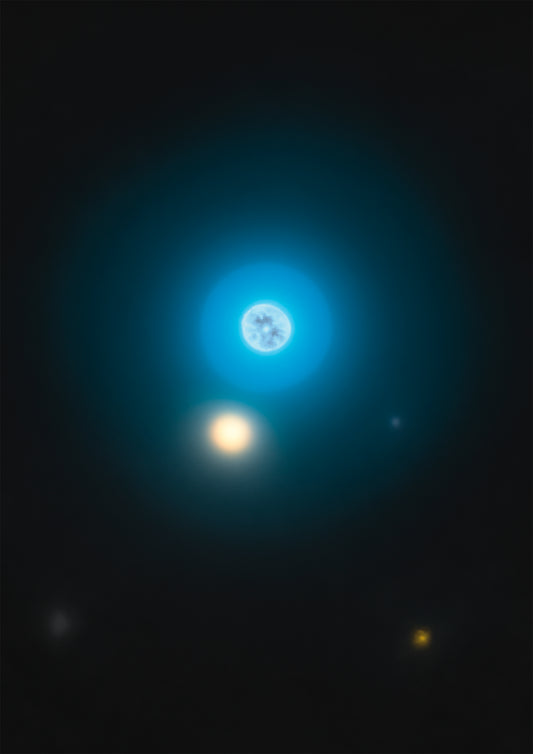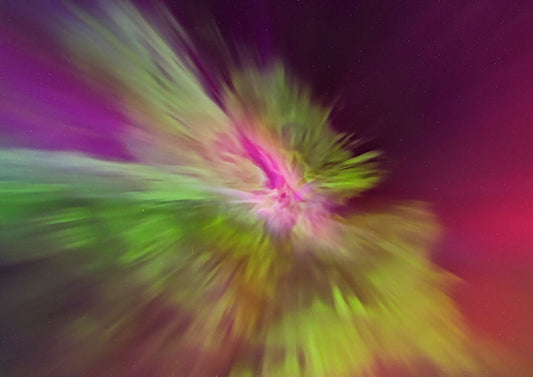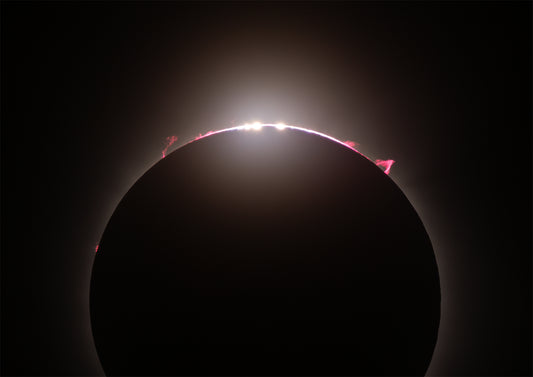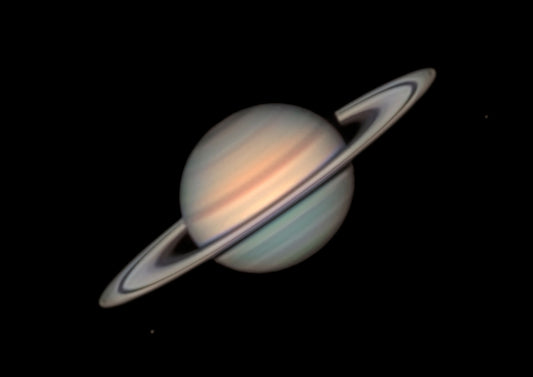We are excited to introduce a collaborative project that was born from the minds of two obsessive and perhaps overly-stubborn astrophotographers, Jason Guenzel and Douglas J Struble. Doug and I became friends somewhere around 8 years ago as we began getting serious about the hobby around the same time. Living near to other, we participate in the same local club and struck up a mutual interest in going after these challenging targets. It's about time we put our heads together and came up with a collaboration image.
We chose to work on IC 3568, The Lemon Slice Nebula. This was a project we had never seen attempted and perhaps for a very good reason. It is an exceedingly small planetary nebula when viewed from Earth. It is so small, in fact, it is rarely given much attention from the amateur astrophotography community. The bright inner core measures a paltry 6 arc-seconds, placing it somewhere around the apparent size of Mercury in the sky. Put another way ... it's a bit like photographing an actual lemon slice from a distance of 1 mile (1.6 km)!

We pushed our techniques (and sanity) into new territory in an attempt to reveal the tiniest of details from our collective dataset. The results amazed us both and simply would not have been possible without our combined and experimental efforts in capture and processing.
The image displayed here was fully deconstructed into constituent parts and then reassembled into a view that encapsulates an incredible dynamic range, providing a look deep into the core of the nebula while also revealing its place within the cosmic starscape.

This view shows our full field of view (spanning roughly the size of the full Moon in the sky) just to give a visual on just how small this object is ... comparable to a single small lunar crater !
The nebula itself gets its name from one of the first false color renditions shown here from the Hubble Space Telescope, in which it was rendered yellow.

This made it resemble a lemon in cross section, but the nebula is actually dominated by blue-green oxygen emission. We present it here in a more natural color balance; the color it appears visually if observed with a large enough telescope. The inner bright core, as mentioned, is tiny as viewed from Earth, but still extends over one tenth of a light year in diameter. Placed over our solar system, it would cover it entirely beyond the orbit of Pluto and the Kuiper belt, leaving only the outer Oort Cloud exposed! The nebula morphology is fairly standard for a young planetary nebula and is consistently spherical in nature, displaying at least two discernible outer shells.
Scattered across the background we see hundreds of far flung galaxies dotting the background. The largest collection identified here is not fully cataloged but redshift data pins the distances at over 2.5 billion light-years. The image below shows that distant, red-shifted arc of galaxies.

Perhaps my favorite crop of this area is the one that balances the nebula against this galaxy cluster (see below), though it is admittedly hard to discern the planetary nebula which is no bigger than some of the stars within the field.

Some details about the imaging and processing techniques:
Overall, the dataset is composed of LRGB broadband and OIII narrowband sub-exposures with shorter OIII exposures for the core. Images collected with both of our telescope systems were combined. We processed the data extensively in an attempt to provide our best interpretation of the object and everything around it. Portions of the image were processed independently and then merged back into the composition. The final image is not reflective of the raw resolving power of our imaging systems, but is rather a result of our relentless work in teasing out all of the minuscule bits of information we could (while keeping the artifacts and noise at bay).
Initially, we focused our attention on the very small inner core. In an attempt to extract some details, we excessively dithered over 1000 shorter 30s sub-exposures to enable a rather-ridiculous drizzle factor of 8x. The resulting cropped image stack was loaded with atmospheric and optical blurring (and plenty of artifacts) from the process. It was then progressively processed with PixInsight deconvolution algorithms at multiple scales (custom PSFs) as well as rounds of wavelet sharpening. Finally, the resulting core image was passed to Photoshop for final artifact removal, sharpening, contrast enhancement and balancing.
Once we were happy with the core, our attention fell to the rest of the image which now seemed rather lacking. So, we captured additional LRGB and deep OIII long exposures to improve the overall look and balance it as best we could with the incredibly tiny core data. The background dataset was processed with more traditional methods at a more-sane image scale of 2x drizzle. The final efforts revealed extended OIII structures and background galaxies.
From there, it was upscaled to match the core, resulting in a final image resolution of over 1 gigapixel. Then all the layers were merged and balanced into the final composition. The images presented here are several crops from the full composition (in most cases downscaled to keep the viewing experience reasonable).
Final Words
All told, we probably put an unreasonable amount of effort into making this collaboration the best it could be for such an incredibly challenging target. We started collecting images way back in 2022 and slowly worked through the tedious process. It feels great to finally be able to share it.
We decided to do a short run of prints for the close-up shot. If you are interested in checking it out, hit the link here to the store...
This photograph also appears on Astrobin with more details and information link here or tap the image below.
Finally, we hope you find the image as interesting as we do. It certainly took a long time to get "right" for a couple of perfectionists working from suburban light pollution. Hopefully you can appreciate the work that went in, as we finally get to enjoy the results!
- Jason and Doug, brothers-in-integration





